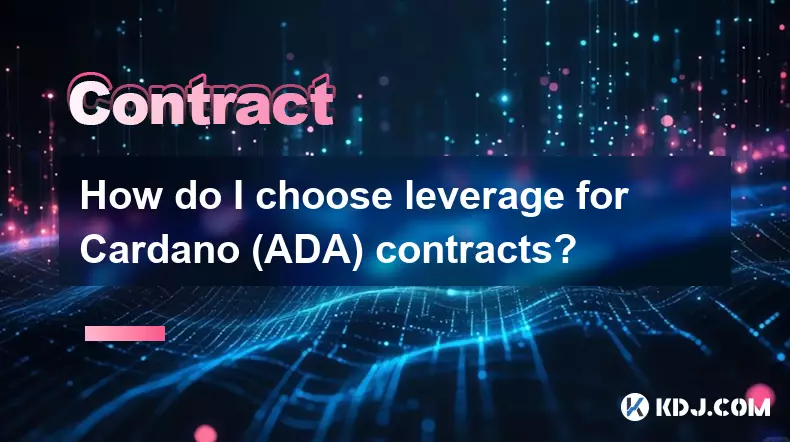-
 bitcoin
bitcoin $122090.672462 USD
1.59% -
 ethereum
ethereum $4493.758974 USD
0.56% -
 xrp
xrp $3.033145 USD
0.65% -
 tether
tether $1.000629 USD
0.00% -
 bnb
bnb $1169.854250 USD
7.07% -
 solana
solana $230.954786 USD
-0.19% -
 usd-coin
usd-coin $0.999785 USD
0.00% -
 dogecoin
dogecoin $0.256108 USD
-1.12% -
 tron
tron $0.342333 USD
-0.12% -
 cardano
cardano $0.859632 USD
-0.10% -
 hyperliquid
hyperliquid $48.932146 USD
-2.25% -
 chainlink
chainlink $22.345466 USD
-1.29% -
 ethena-usde
ethena-usde $1.000217 USD
-0.03% -
 avalanche
avalanche $31.203456 USD
1.93% -
 sui
sui $3.579145 USD
1.05%
How do I choose leverage for Cardano (ADA) contracts?
Leverage in ADA futures amplifies both gains and risks, making proper risk management essential for traders at all experience levels.
Sep 29, 2025 at 08:01 am

Understanding Leverage in Cardano (ADA) Futures Trading
1. Leverage allows traders to control a larger position in Cardano (ADA) with a smaller amount of capital. When engaging in futures contracts, leverage amplifies both potential gains and losses. A 10x leverage means that every 1% move in ADA’s price results in a 10% change in the trader’s equity. This dynamic makes understanding leverage essential before entering any trade.
2. Different exchanges offer varying levels of maximum leverage on ADA perpetual or futures contracts, ranging from 5x to as high as 100x. Higher leverage increases risk exposure significantly. For instance, a 50x position could be liquidated with just a 2% adverse move in price. Traders must assess their risk tolerance and trading strategy when selecting an appropriate level.
3. Market volatility plays a crucial role in determining suitable leverage. ADA, while generally less volatile than some altcoins, can still experience sharp swings during macroeconomic events or major network upgrades. During periods of heightened volatility, lower leverage is often advisable to prevent premature liquidation.
4. Position size interacts directly with leverage. Using high leverage on a large position can quickly deplete margin balance if the market moves against the trader. It is critical to calculate the total exposure and ensure it aligns with account size and risk parameters.
5. Risk management tools such as stop-loss orders and take-profit levels become even more vital when using leverage. These mechanisms help define exit points in advance, reducing emotional decision-making during fast-moving markets. Setting these limits helps preserve capital over time, especially in unpredictable conditions.
Choosing the Right Leverage Based on Experience Level
1. Beginners should start with low leverage, ideally between 2x and 5x, to gain familiarity with margin mechanics without exposing themselves to excessive risk. Learning how funding rates, mark prices, and liquidation thresholds work is easier when positions are not overly sensitive to minor price fluctuations.
2. Intermediate traders who have developed a consistent strategy may consider leveraging between 10x and 20x, provided they maintain strict risk controls. At this level, proper position sizing and accurate entry/exit planning are mandatory to avoid significant drawdowns.
3. Advanced traders sometimes use higher leverage for short-term scalping or arbitrage opportunities where holding periods are minimal. Even experienced traders face substantial risk at 50x or above, so such levels should only be used with well-tested systems and tight monitoring.
4. Psychological factors also influence leverage choice. High leverage can induce stress and lead to impulsive decisions, particularly during rapid price movements. Maintaining discipline requires aligning leverage with one’s emotional capacity to handle pressure.
5. Backtesting strategies under different leverage scenarios provides insight into how a system performs across market cycles. Historical data analysis helps determine whether increased leverage improves risk-adjusted returns or simply amplifies instability.
Impact of Exchange Conditions on Leverage Selection
1. Not all platforms treat ADA contracts the same way. Some exchanges adjust maintenance margin requirements based on open interest or volatility, which affects how much leverage can be safely utilized. Traders must review each platform's margin rules before committing funds.
2. Funding rates for ADA perpetual swaps vary across exchanges and can erode profits over time, especially when holding leveraged positions for extended durations. High-frequency traders might prioritize platforms with lower average funding costs when deploying moderate to high leverage.
3. Liquidation engines differ in efficiency and transparency. Certain platforms use insurance funds to cover bankruptcies, while others rely on auto-deleveraging systems that could impact active traders during extreme volatility. Understanding these mechanisms influences how aggressively one can use leverage.
4. Availability of deep order books and tight spreads supports higher leverage usage by reducing slippage. Exchanges with strong liquidity in ADA pairs allow traders to enter and exit positions more predictably, minimizing unexpected losses due to poor execution.
5. Regulatory environment indirectly affects leverage availability. Some jurisdictions restrict maximum leverage on crypto derivatives, forcing exchanges to limit options for users in those regions. Traders must comply with local regulations while evaluating available contract terms.
Frequently Asked Questions
What happens if my ADA leveraged position gets liquidated?When a leveraged ADA position breaches the maintenance margin threshold, the exchange automatically closes it to prevent further losses. The remaining collateral after covering losses becomes available again, though partial or full loss of margin is common.
Can I change leverage during an active ADA futures trade?Most exchanges allow adjustment of leverage even with open positions, but doing so alters the margin allocation and can trigger immediate liquidation if the new setting reduces buffer space too much. Adjustments should be made cautiously and preferably when the market is stable.
Does higher leverage affect ADA trading fees?Trading fees are typically based on notional value and tiered account status, not directly on leverage. However, since higher leverage enables larger positions, the absolute fee amount increases proportionally with trade size.
Disclaimer:info@kdj.com
The information provided is not trading advice. kdj.com does not assume any responsibility for any investments made based on the information provided in this article. Cryptocurrencies are highly volatile and it is highly recommended that you invest with caution after thorough research!
If you believe that the content used on this website infringes your copyright, please contact us immediately (info@kdj.com) and we will delete it promptly.
- BlockDAG, DOGE, HYPE Sponsorship: Crypto Trends Shaping 2025
- 2025-10-01 00:25:13
- Deutsche Börse and Circle: A StableCoin Adoption Powerhouse in Europe
- 2025-10-01 00:25:13
- BlockDAG's Presale Buzz: Is It the Crypto to Watch in October 2025?
- 2025-10-01 00:30:13
- Bitcoin, Crypto, and IQ: When Genius Meets Digital Gold?
- 2025-10-01 00:30:13
- Stablecoins, American Innovation, and Wallet Tokens: The Next Frontier
- 2025-10-01 00:35:12
- NBU, Coins, and Crypto in Ukraine: A New Yorker's Take
- 2025-10-01 00:45:14
Related knowledge

What is the difference between futures and perpetual contracts for Bitcoin?
Oct 02,2025 at 11:54pm
Understanding Bitcoin Futures Contracts1. Bitcoin futures are derivative instruments that allow traders to speculate on the future price of Bitcoin at...

What is the best time to trade PEPE contracts?
Oct 03,2025 at 11:54am
Understanding PEPE Contract Volatility1. PEPE contracts exhibit extreme price fluctuations due to their meme-based nature and low market cap. Trading ...

What are the common mistakes to avoid with Bitcoincoin contracts?
Oct 03,2025 at 08:54am
Emerging Trends in the Cryptocurrency Market1. Decentralized finance (DeFi) platforms continue to expand their influence across the blockchain ecosyst...

What is the maintenance margin for Bitcoin contracts?
Oct 02,2025 at 01:36am
Decentralized Exchanges Gain Momentum in 20241. Decentralized exchanges (DEXs) have seen a significant rise in trading volume, surpassing centralized ...

How to use technical analysis for trading XRP contracts?
Oct 03,2025 at 01:18pm
Understanding Price Patterns in XRP Futures1. Identifying chart patterns such as triangles, head and shoulders, and double tops or bottoms can provide...

What does "longing" PEPE contracts mean?
Oct 03,2025 at 11:54pm
Understanding Decentralized Exchanges in the Crypto Ecosystem1. Decentralized exchanges (DEXs) operate without a central authority, allowing users to ...

What is the difference between futures and perpetual contracts for Bitcoin?
Oct 02,2025 at 11:54pm
Understanding Bitcoin Futures Contracts1. Bitcoin futures are derivative instruments that allow traders to speculate on the future price of Bitcoin at...

What is the best time to trade PEPE contracts?
Oct 03,2025 at 11:54am
Understanding PEPE Contract Volatility1. PEPE contracts exhibit extreme price fluctuations due to their meme-based nature and low market cap. Trading ...

What are the common mistakes to avoid with Bitcoincoin contracts?
Oct 03,2025 at 08:54am
Emerging Trends in the Cryptocurrency Market1. Decentralized finance (DeFi) platforms continue to expand their influence across the blockchain ecosyst...

What is the maintenance margin for Bitcoin contracts?
Oct 02,2025 at 01:36am
Decentralized Exchanges Gain Momentum in 20241. Decentralized exchanges (DEXs) have seen a significant rise in trading volume, surpassing centralized ...

How to use technical analysis for trading XRP contracts?
Oct 03,2025 at 01:18pm
Understanding Price Patterns in XRP Futures1. Identifying chart patterns such as triangles, head and shoulders, and double tops or bottoms can provide...

What does "longing" PEPE contracts mean?
Oct 03,2025 at 11:54pm
Understanding Decentralized Exchanges in the Crypto Ecosystem1. Decentralized exchanges (DEXs) operate without a central authority, allowing users to ...
See all articles










































































